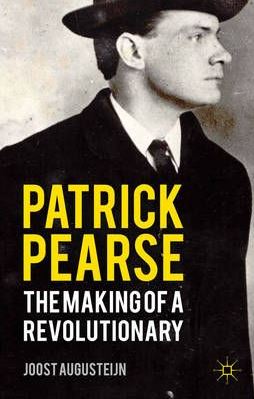 Reviewer: Wouter van Dijk
Reviewer: Wouter van DijkPatrick Pearse. The making of a revolutionary, Joost Augusteijn
Palgrave MacMillan, Basingstoke 2010
ISBN: 978 0 230 27765 6
Paperback, illustrations in black and white, family tree, notes, bibliography and index.
428 pages
€ 30,99 [£ 20,99]
The life of P.H. Pearse
None of the leaders of the 1916 Easter Rising in Ireland have drawn so much attention to them after their death as Patrick Henry Pearse, while at the same time large parts of especially his private and early life have stayed in the shadows until now. Sometimes hailed as a visionary, sometimes ridiculed as a parvenu, there is no doubt the life of Pearse is worth a thorough biography. And thorough is what Augusteijn’s work can be called. Already in the preface of the book Augusteijn emphasises the need for a new biographical monograph concerning the life of Pearse, stating that the wide-known work of Ruth Dudley-Edwards on Pearse[1] has become outdated and needs revision, hence his book. Augusteijn is lecturer in modern history at Leiden University, and specialized in the history of Irish Republicanism and the history of political violence in general. In the past he has published numerous articles and books on these subjects.
What Augusteijn does in his book is mainly to show that Pearse and his huge enthusiasm for cultural nationalism and also his development into a political revolutionary, wasn’t so unique after all. Showing the dominance of these movements in Europe at the time Pearse grew up and, years later, became politically interested, Augusteijn makes clear Pearse was above all a child of his time.
Dividing the book thematically into six chapters, the author treats each aspect of Pearse’s life in each chapter mostly chronologically. He starts with the investigation of Pearse as a person, describing his family on both the mother’s and father’s side and Pearse’s childhood. Then follow chapters dedicated to Pearse as a cultural nationalist, and educationalist. After that Pearse the politician and revolutionary are treated. The last chapter is reserved for a very interesting and valuable discussion of Pearse’s ‘legacy’. The way his thoughts and writings have been used in post-Pearse Ireland, during the years of the Anglo-Irish and Civil War, but also and especially later on, after the Second World War and onwards.
Augusteijn clearly shows several flaws in Dudley-Edwards’ book on Pearse, for example when he writes about the role of the young Pearse’s family in making him a future revolutionary. Dudley-Edwards lays much emphasis on the Fenian stories and tales Pearse’s aunt told him when he was a kid. Augusteijn invalidates this ‘uniqueness’ of the Pearse case by explicating the commonness in the early 1900’s in Ireland of having family members being involved in the Fenian movement in the second half of the nineteenth century. Pearse’s upbringing full of republican and violent stories in no way made him a predestined nationalist, let alone a physical-force revolutionary.
While progressing through the book, the convincing impression is stowed upon the reader that Pearse only at a relatively late moment in his life became interested in Irish nationalism. At secondary school for example, he did still saw Ireland as a perfectly normal part of the United Kingdom. It is not before somewhere around the beginning of the twentieth century that he begins to speak of a “battle of two civilizations”, when describing the relationship between Ireland and Great Britain. Even so, until just before the rising in April 1916, he placed the cultural nationalism of the language movement on a higher level than the political nationalism of, for example, the nationalist of the Irish Nationalist Party but also of the revolutionaries of the Irish Republican Brotherhood. Even in 1915 he described in one of his stories the use of violence as a typical English phenomenon.
The further the reader gets in the book, the more he will be caught up in it when in the last chapters it is noticeable Augusteijn gets to his specialization; revolutionaries and political violence. Instead of a more describing way of writing in the first chapters, in these last chapters there are a lot more analyses and comparisons with political and international developments to be found. And that’s a big asset for readers interested in the revolutionary aspect of Pearse’s life. One of Augusteijn’s conclusions worth mentioning is that the so-called ‘bloodthirst’ some authors have accused Pearse of, and which is visible in Pearse’s speeches and writings from the last part of his life, wasn’t unique at all. Not even for Irishmen, let alone Pearse as an individual, rather on the contrary. Phrases and expressions glorifying the ‘giving of young blood for honour’, and ideas about the ‘cleansing quality of shedding blood on the battlefield’ were used in early twentieth century Europe all the time. Examples of this can be found in the writings and speeches of Bonar Law, Churchill, and Thomas Mann, to name a few.
All in all this first new biography of Patrick Pearse in about thirty years is a welcome and very valuable addition to the bookshelves of articles and books already published about the first president of the provisional Irish Republic. Especially scholars and students of Irish Republicanism, and those interested in the person of Pearse of course, will find in this book a worthy addition to their bookcase.
Wouter van Dijk
[1] R. Dudley-Edward, Patrick Pearse. The Triumph of Failure (Dublin 2006)
